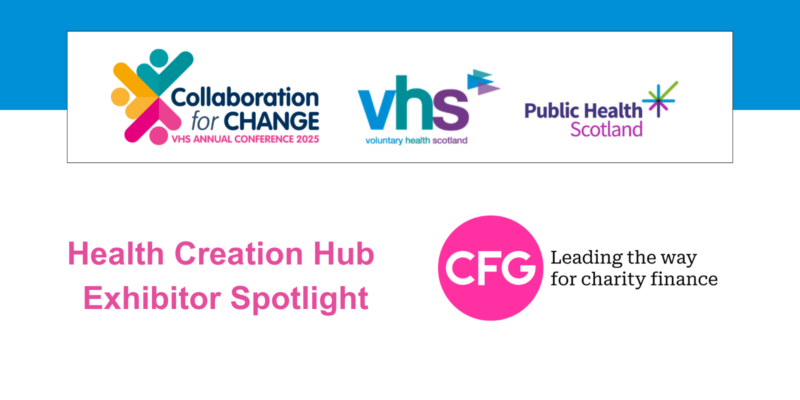
Moving from dialogue to true collaboration can feel like climbing a double helix; it isn’t a straight path. Emma Abbott, Communications Manager at Charity Finance Group (CFG), shares the lessons learned from a recent collaboration between the charity sector and some of the UK’s biggest banks.
History is littered with examples of great partnerships and collaborations, particularly in the health, social and charity sectors. It took teams of people to discover radioactivity, DNA and, more recently, the hepatitis C virus. Of course, great collaborations don’t have to be Nobel prize-winning to make a big difference. Every day across the charity and voluntary sector people come together with shared goals – and the impact is enormous.

At Charity Finance Group (CFG) we know that our charity members are our strength and that two or more heads are better than one. But what does genuine, successful collaboration look like? And how do we make it happen?
We’ve been reflecting on this lately through our work with the banking sector. In 2024 we surveyed charities across the UK about their banking services and discovered that thousands of staff and volunteer hours were being lost to routine tasks such as paying in cash and changing trustees’ names on a mandate – time much better spent on delivering charitable services.
We knew we couldn’t solve this alone; we needed to work with the banks. So we re-established the Charitable Sector Banking Forum in autumn 2024 and invited all the key players.
Learning about the regulatory and operating environment that banks work within was eye-opening, and the banks felt the same when we explained how charities work. By actively listening to one another we marked a clear starting line for collaboration.
Beware of the conversation trap
We’ve all sat through meetings where everyone has been heard, ideas shared, and every head is nodding. This can look and feel like collaboration, but all too often it lacks substance – it’s ‘conversation theatre’. The trap is believing that understanding each other’s perspectives is the end goal rather than the starting point. Constructive conversation creates the conditions for collaboration and tangible action but doesn’t constitute it.
Commit, decide and deliver
You’ve got the right people in the room, you’ve listened and learned and you’ve agreed that things must change. Don’t trick yourself into thinking that alignment is enough.
After discussion, ask: Who owns this? What specifically will they do? By when? What support do they need? Who else needs to be involved? Some organisations ritualise asking these questions by making time before the meeting ends to convert ideas into firm commitments.
Clear decision-making is fundamental to progress. At CFG we use the RASCI (Responsible, Accountable, Supporting, Consulted, Informed) framework. It confirms roles and establishes how decisions are made and by whom.
Infrastructure matters
For truly successful collaboration you need to build the infrastructure around it. Trust and transparency fuel collaboration, from the humble shared document to communications protocols, workflows and project plans. Regular check-ins and feedback mechanisms provide the structure within which collaboration can flourish.
A note about trust – it’s a verb not a noun. Through our collaborations, we’ve learned that trust is built through small, consistent actions. It means reliability. Be upfront about the way you work, the way you want to work and what timelines and goals you’ll set. Getting these basics right is especially important when collaborating with organisations or groups outside of your own.
 Aim for productive tension
Aim for productive tension
True collaboration can only come about when all those involved have a sense of psychological safety – ability to share and speak without fear of repercussion. However, in the quest for this, you can inadvertently create an environment that pushes out helpful challenge. Without willingness to disagree, push back and hold each other accountable, politeness can trump progress.
The sweet spot comes from blending psychological safety with healthy conflict to create ‘productive tension’. This is central to CFG’s own culture and crucial to our work as an infrastructure and membership body. Tension isn’t always negative – many things depend on it, and collaboration is one of them.
Measure what matters
What gets measured gets managed, and collaboration is no exception. Measuring inputs, outcomes and impact is a whole other article (head to our Knowledge Hub to learn more) but simply, we chose to focus on the outputs of our collaboration with the banks, rather than tactics or longer-term impact.
We recommend having that conversation upfront and agreeing what success looks like for everyone. Ask yourself if what you’re measuring actually matters, or whether it’s measurement for measurement’s sake. It’s not a stick to beat the group with, but a means to feed back, learn and improve.
Collaborate then celebrate
One year on from launching our Banking Challenges Survey, we’ve made notable progress – and that’s worth celebrating! We published a guide for charitable organisations to help them communicate more effectively with their banks. We’ve also developed and launched a training programme – supported by NCVO – for a well-known high street bank, giving staff and leaders a deeper understanding of how charities operate and what they need from their banking services to be more efficient and impactful.
That’s what success looks like to us.
Find out more – visit our booth…
This is just one success story among many that we’d love to share with you. We work across the UK with charity finance and operations professionals, corporate partners, parliamentarians, government departments and other infrastructure organisations to improve the operating and regulatory environments for charitable organisations.
Visit our website to find out more about CFG and how to join us. Or email our friendly team. Here’s to more fruitful collaborations and partnerships!
 We’re excited to be joining with you at the VHS conference, so please pop over to our booth and say hello!
We’re excited to be joining with you at the VHS conference, so please pop over to our booth and say hello!
Photo Sources: Adobe Stock
